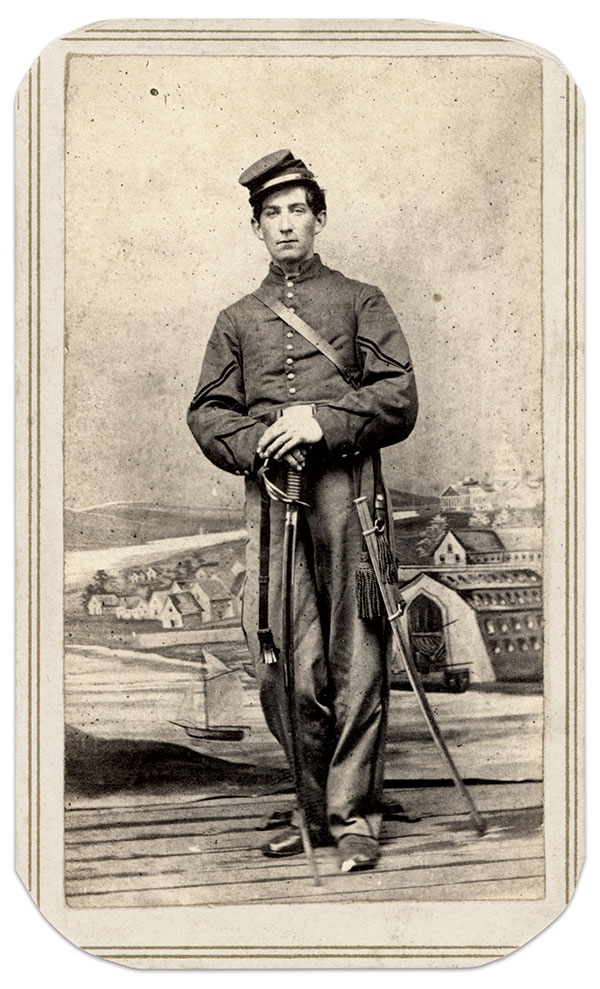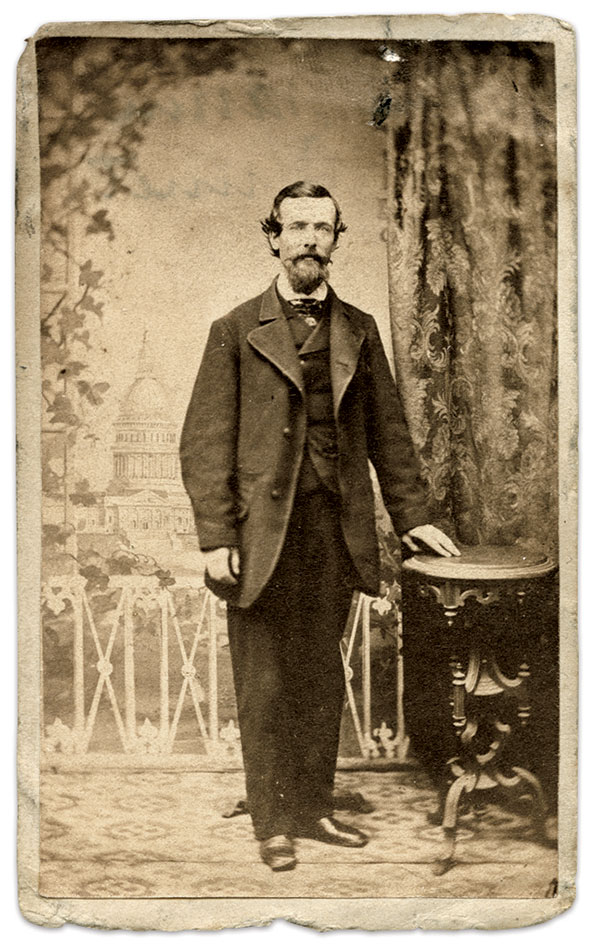By Adam Ochs Fleischer

A central theme of this column since its inception is that backdrops used in Civil War images generally suggest the photographer’s location. It can be fairly assumed, for example, that backdrops showing palm trees were located in a tropical climate, where such flora is found. Similarly, painted architecture and landscape can also hint at where a subject’s portrait was taken. A large winding river might signify proximity to the Mississippi, for instance.
However, the inclusion of evocative elements is not always helpful in narrowing down a studio’s specific location. The knowledge that a soldier’s portrait was taken somewhere near the Mississippi can really be used to no purpose if nothing else about the image is known. Some features too, like palm trees, provide such a broad suggestion of place that the information is not especially pertinent. Palm trees are located in numerous states along the southeastern seaboard. What’s more, it seems some photographers were using backdrops that were intended to express a soldier’s future destination, rather than his current location. This is best exemplified by the backdrop I named “The Palm Tree Backdrop of Jackson, Michigan,” discussed in the Winter 2022 issue.
The backdrops we are discussing in this installment are perhaps unique in that they feature a distinctive landmark immediately recognizable to most as a definitive marker of location: the United States Capitol building in Washington, D.C.
Larger Capitol, bigger dome

Growth and expansion of the country during the antebellum period resulted in a larger Congress, necessitating a larger building to house its members. Additions were constructed on the north and south wings of the Capitol in the 1850s, and while the new space accommodated more people, it made the existing dome atop the structure appear small and asymmetrical in relation to its long sides. In 1855, construction began on a new dome designed after St. Peter’s Basilica in Rome and sold on the promise that it would be a crown fit for the head of the federal government.
Domes have historically been figural capstones of achievement: Brunelleschi’s dome atop the Florence Cathedral, for instance, cemented the city as seat of the Renaissance upon its completion in 1436. Early Americans saw themselves and their government as a rebirth of enlightenment ideals, and took as their inspiration the architectural principles of the neoclassical and Renaissance movements.
Despite logistical and financial difficulties presented by the Civil War, progress on the dome continued throughout the conflict. Several photos of President Lincoln’s inaugural address in March 1861 show an incomplete dome replete with cranes and wood scaffolding. In 1863, the Statue of Freedom by Thomas Crawford was installed on the dome’s cast iron pedestal, and in 1866, all scaffolding was removed. The dome was complete.
About the backdrops
A survey of backdrops showing the Capitol yields at least 3-5 distinct variations. This is interesting, because they are very uncommon to see, especially in a hard image format. The diversity of examples and their limited number would suggest that many photographers were using similar backdrops in the Washington area but that none were especially prolific.
With respect to the dating of images featuring the Capitol building and its seemingly completed dome, evidence suggests that they were wartime and were not taken after 1866. Many examples lack revenue stamps which would indicate they were taken before 1864. The absence of scaffolding and the finished appearance of the dome must have been the product of several artists’ imaginations. However, since the dome was nearly completed by 1863, it did not likely take much creativity to envision its finished form.
Photographers Schroeder and Rakeman

One photographic firm that we can tie with certainty to the usage of a backdrop featuring the Capitol building with a completed dome is that of Schroeder and Rakeman on 7th Street in Washington. All examples of their work are thus far recognized as being in the carte de visite format. Their backdrop is curious in that a tintype exists (opposite page), that looks extremely similar. Though the railing in the foreground appears different, other minutiae are identical. This suggests the tintype’s backdrop is the same as Schroeder and Rakeman’s, and that it has been altered, or that an artist was producing similar products (perhaps with a stencil).
Adam Ochs Fleischer is a passionate researcher of Civil War photography and an admitted image “addict.” He began collecting in high school and quickly became obsessed. He lives in Columbus, Ohio.
SPREAD THE WORD: We encourage you to share this story on social media and elsewhere to educate and raise awareness. If you wish to use any image on this page for another purpose, please request permission.
LEARN MORE about Military Images, America’s only magazine dedicated to showcasing, interpreting and preserving Civil War portrait photography.
VISIT OUR STORE to subscribe, renew a subscription, and more.

